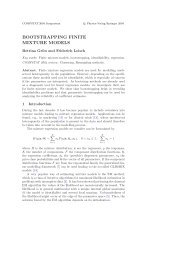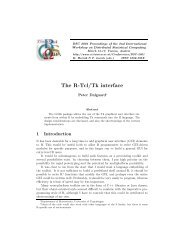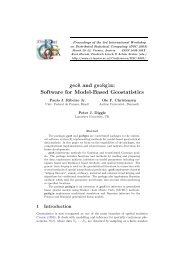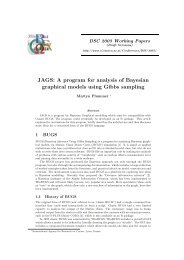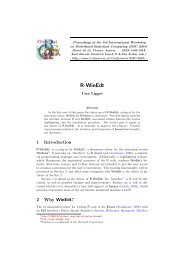Embedding R in Windows applications, and executing R remotely
Embedding R in Windows applications, and executing R remotely
Embedding R in Windows applications, and executing R remotely
Create successful ePaper yourself
Turn your PDF publications into a flip-book with our unique Google optimized e-Paper software.
Performance of Sp<strong>in</strong>al Support<strong>in</strong>g Muscles under Different Angles of Sp<strong>in</strong>al Flexion<br />
for 4 Comb<strong>in</strong>ation of Flexion/Extension <strong>and</strong> Sitt<strong>in</strong>g / St<strong>and</strong><strong>in</strong>g Positions.<br />
Keyhani, M. Reza* (MSc. Biomefry); Dr. Farah<strong>in</strong>i, Hossa<strong>in</strong>** (Orthopedist);<br />
Ebrahimi, Ismaeel* (PhD. Physiotherapy); Taheri, Navid *** (MSc. Physiotherapy)<br />
Low back pa<strong>in</strong> is a common problem throughout the world.<br />
To provide, or evaluate, a preventive, or therapeutic, exercise<br />
program, a physiotherapist should be familiar with the<br />
functional biomechanics of sp<strong>in</strong>e <strong>and</strong> muscles support<strong>in</strong>g it.<br />
This study was designed, as an explanatory research, to<br />
provide necessary <strong>in</strong>formation about the performance of sp<strong>in</strong>al<br />
support<strong>in</strong>g muscles, when the lumbar sp<strong>in</strong>e flexes at angles<br />
of 0, 20, 40 <strong>and</strong> 60 degrees <strong>in</strong> four comb<strong>in</strong>ation of flexion/<br />
extension <strong>and</strong> sitt<strong>in</strong>g/st<strong>and</strong><strong>in</strong>g positions. To measure the<br />
performance of the muscles, a modified ISO-Station 200 – B<br />
<strong>in</strong>strument was used . This <strong>in</strong>strument measures the<br />
performance via maximun <strong>and</strong> average torques.<br />
Behavior of max.torques was the same as ave.torques; hence<br />
the latter was selected as the response variable of the study.<br />
Explanatory variables of the study are:<br />
(1) Flexion.Angle of the lumbar sp<strong>in</strong>e hav<strong>in</strong>g values of 0, 20, 40 & 60 degree.<br />
(2) St<strong>and</strong><strong>in</strong>g position with values: 1 = St<strong>and</strong><strong>in</strong>g , 0 = Sitt<strong>in</strong>g.<br />
(3) Extension position with values: 1=Extension, 0 = Flexion.<br />
(4) COMBINATION with values: Ext.Sit, Flex.Sit, Ext.St<strong>and</strong>, Flex.St<strong>and</strong>.<br />
This is a repeated measure problem where the response variable is measured at 16 different conditions for<br />
each participant. Participants were 30 healthy male students with age range of 20-30 years.<br />
Besides various summary statistics & graphs, basically we can expla<strong>in</strong> the whole picture of the study, by<br />
us<strong>in</strong>g three R- functions:<br />
(1) <strong>in</strong>teraction.plot (Flexion.Angle, COMBINATION, ave.torque)<br />
(2) summary (aov (ave.torque~ (Flexion.Angle + St<strong>and</strong> + Ext)^2 + Error(participant)))<br />
Torque (N.m)<br />
max. torque & avg.torque are calculated by<br />
ISO-Station 200-B<br />
COMBINATION<br />
mean of ave.torque (N.m)<br />
Flexion.Angle<br />
* School of Rehabilitation Sciences – Iran Medical Sciences University – Tehran – Iran<br />
** School of Medic<strong>in</strong>e – Iran Medical Sciences University – Tehran – Iran<br />
*** School of Rehabilitation Sciences – Isfahan Medical Sciences University – Isfahan – Iran




